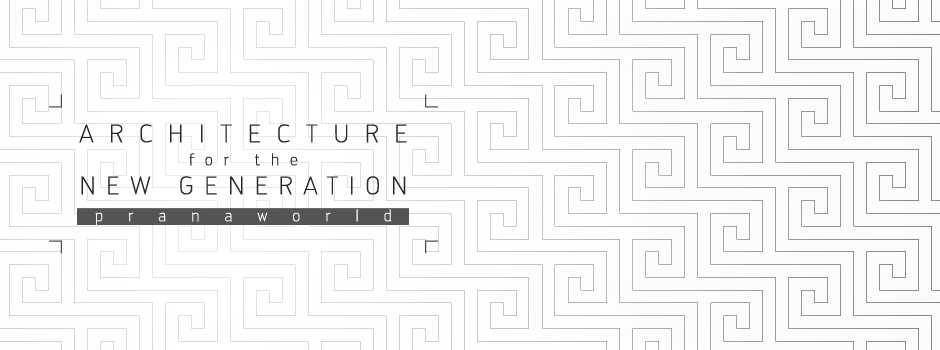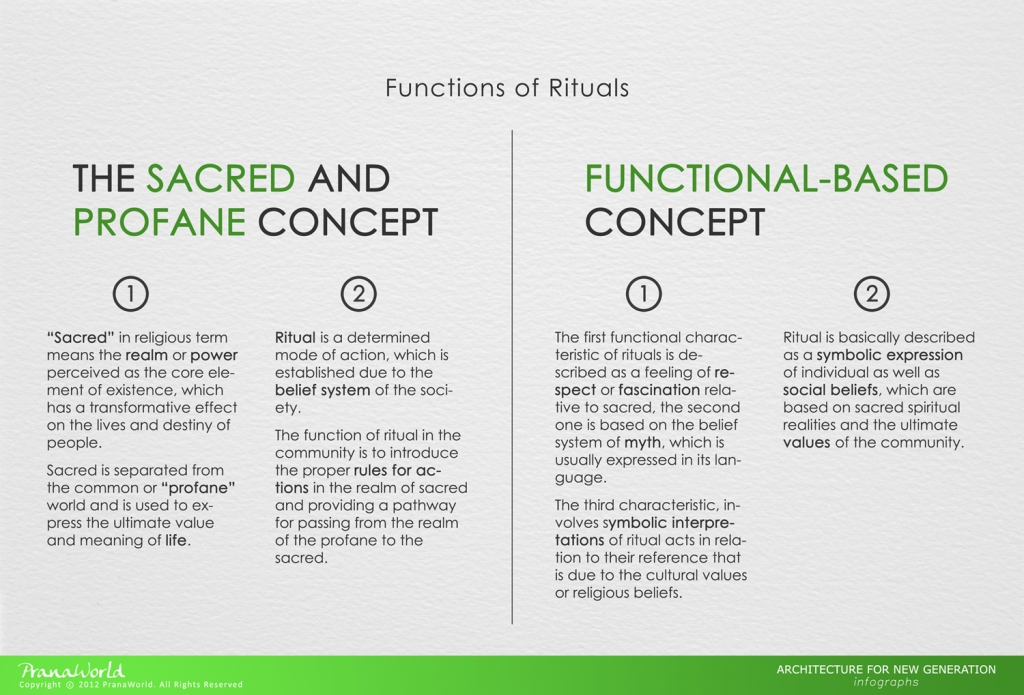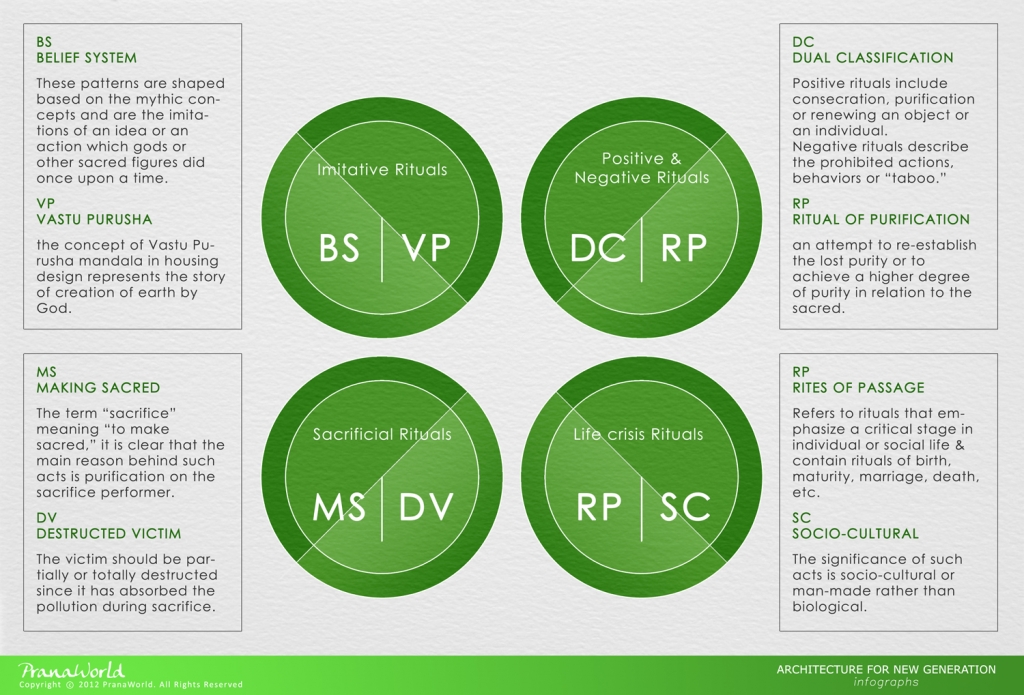
The study of rituals as the very first traces of human evolution is highly significant in the field of architecture and human built space. Rituals as manifestations of cultural beliefs and values have always imposed certain forms, patterns and symbolic decorations to the architectural built space, however the reason behind practicing such acts are not fully understood today. Therefore a thorough study of rituals and their connections to the formation of traditional architecture is needed to have a better understanding of the patterns of human behavior and culture and its influence on human built space.
Introduction
Ritual in term means the performance of ceremonial acts due to the traditional commissions or sacerdotal decrees. It is also being used in modern times to address an established routine or standard act. As ritual is a mode of behavior performed by the people of different cultures in different ages, it is possible to view ritual as a way of understanding and describing the human nature.
Although human can be described as basically a rational being, he can be viewed as ritualistic as well. In this way there would be a parallel connection between ritual and verbal behavior of the human nature. Ritual as language, consists of a set of symbols based upon some prescribed rules. In almost every theory dealing with ritual behavior, language is considered a crucial factor in defining the nature of rituals, and the specific form of language used in explaining the ritualistic acts is the language of myth while both myth and ritual are considered as the foundations of any religion.
It is hypothesized that rituals, as a well-established set of rules, have been established by the sum experience of generations dealing with forces of nature, which is often categorized under beneficial or harmful, positive or negative. Since there was no written language to transfer the experienced knowledge to future generations, rituals have been used. Hence rituals are important parts of any society or culture to understand their cultural values and architectural discoveries.
By the rise of language as a communicating method and books as a collection of historical discoveries, the role of rituals became vague but they were still considered as important parts in the process of architecture. The development of the mental faculty of the modern man, and his detachment from nature as a divine existence, changed the look of the rituals to guidelines or standards. However, rituals of the past were the combination of physical, psychological and spiritual discoveries while the architectural standards of the day only consider physical and partially psychological aspects of human experience.
According to Britannica Encyclopedia there are three main approaches to ritual definition including the “origin approach” which follows a chronic evolutionary concept, the “functional approach” which tries to uncover the functions of ritual acts and the “history of religions approach” which accounts myth as the basic concept in the creation of rituals.
Functions of Rituals
The observation of rituals throughout history, apart from its symbolic significance, describes these ceremonial acts as an established set of rules and regulations. One view is to look at the function of these acts as a classification of sacred and profane while the second view indicates them as functional-based acts apart from the concept of sacred or evil. In fact, the emphasis of the second view is to denote the function of ritual behavior in the society.
The Sacred and Profane Concept
The rules are commonly classified into the two categories of “sacred” which belongs to the transcendent realm and “profane” which means the realm of time, space and “cause and affect.” Based on the author’s view, these two categories may also be viewed as beneficial or harmful due to experimental discoveries of the generations throughout history.
“Sacred” in religious term means the realm or power perceived as the core element of existence, which has a transformative effect on the lives and destiny of people. Sacred can be described by the terms such as holy, perfect, divine or transcendent. Sacred is separated from the common or “profane” world and is used to express the ultimate value and meaning of life. While sacred is identified with pure state that produces health, vigor, luck and fortune, impure state is identified by profane. Profane in Latin term means “in front of or outside the temple” referring to the objects which are not belonging to the church. Hence profane has become a common term to describe impure, insulting or in general any behavior which causes offence.
According to Durkheim sacredness is referred to the elements in the society that are forbidden or set apart. Since these sacred elements are separated by the society, he concluded, the sacred force is society itself. Ritual in this case would be a determined mode of action, which is established due to the belief system of the society. Thus the function of ritual in the community is to introduce the proper rules for actions in the realm of sacred and providing a pathway for passing from the realm of the profane to the sacred. However to Otto things are neither good nor evil, thus the sacred manifests as an ultimate reality and the source of all beings in the universe. In this realm power is undifferentiated between creative or destructive but capable of both and is called the life force, which is the most fundamental concept of religion and ritual.
Sacred” in religious term means the realm or power perceived as the core element of existence, which has a transformative effect on the lives and destiny of people…
Functional-based Concept
Beyond the concept of sacred and profane rituals are divided into three different functional-based categories by the scholars. While the first functional characteristic of rituals is described as a feeling of respect or fascination relative to sacred, the second one is based on the belief system of myth, which is usually expressed in its language. The third characteristic, involves symbolic interpretations of ritual acts in relation to their reference that is due to the cultural values or religious beliefs. In fact discovering the function of rituals in a proper manner is believed to be mainly dependent upon their reference. In this case although there is a common agreement about the symbolic nature of rituals, there exist controversies whether the reference of ritual is symbolic or not.
Ritual is basically described as a symbolic expression of individual as well as social beliefs, which are based on sacred spiritual realities and the ultimate values of the community. The commonly usage of terms, “latent and symbolic,” often refer to the non-rational nature of ritualistic behaviors although they might be logical. Even some scholars such as Austin and Searle believe that semantic interpretations are insufficient in describing the ritual acts since they are performed to serve a function not just bear symbolic information.
Different Types of Ritual Acts
Rituals can be divided into different categories based on their type or method of practice. Although these methods may have common features, the reason behind performing them is significantly distinctive.
Imitative Rituals
Imitative rituals are defined as a practical pattern of the belief system. These patterns are shaped based on the mythic concepts and are the imitations of an idea or an action which gods or other sacred figures did once upon a time. The one example of these rituals is the concept of Vastu Purusha mandala in housing design that represents the story of creation of earth by God, which will happen every time when one wants to build a new dwelling place. Another example is the rituals of the New Year.
These imitative rituals may be followed also based on the practices of the ancient ancestors. For example the ritual of building a new Hogan in Navajo tradition includes reciting a poem, which indicates the way ancestors used to build their houses and thus has a cultural significance.
“… Although the lucky thread-shaped lattice was made of cress-crossed willow wood, happiness and joy are in it.
Although the firm smoke hole of the tent was made with many gaps, it looks like shining precious stones …
The felt is beautiful, it looks like a white sunflower, printed letters are decorated, creation of a Goddess.
I am holding a long pair of scissors in my skillful hand. I was taught by my mother and directed by my elder sisters.
Regarding my skill and knowledge, I was educated by the Nation.
Regarding the structure and shape, I have built it better than anyone …”
Paul Olivier
The rituals associated with traditional architecture mostly belong to this category.
Positive and Negative Rituals
This model represents a dual classification of rituals as positive or negative. Most of the positive rituals include the concepts of consecration, purification or renewing an object or an individual while the negative rites describe the prohibited actions or behaviors. The term “taboo” is a popular term used to describe these set of rituals, which refers to the acts or objects that should be avoided. Although these rules of prohibition cover an infinite variety of rites and behaviors, they all believe that breaking the rules and regulations will result in misery and misfortune. The cure for this law breaking is performing the purifying rites. Hence negative rituals are always in polarity with positive rites.
The purification ritual is basically an attempt to re-establish the lost purity or to achieve a higher degree of purity in relation to the sacred or the social and cultural realms. These ceremonials are found in all known ancient and modern cultures and religions to serve a similar purpose. Purifying rituals and pollution matters are very crucial in social beliefs, since it is believed that pollution as an inner state may spread from one individual or object to other members of the community. Although each culture has its own classification of pure and impure, many similar ideas are found in different cultures. In religious terms, the polluted person is not only destructive for the society but also his health is in danger of being defected by the evil spirits or demons that like the polluted type of energy and may be attracted to the impure person.
Many purification rituals are in fact associated with traditional architecture, especially in building a new dwelling and in settling in.
Sacrificial Rituals
One of the most important rituals is the sacrifice offering acts, which is classified as the first stage of ritual ceremonies and is considered as the earliest form of religion.
Sacrifice is basically different from rituals of oblation, offerings and consecrations. Although a sacrifice act might be accompanied with consecration and offering they do not share the same characteristics. In sacrificial rituals the victim which is a human, an animal, vegetables, etc should be partially or totally destructed through burning, dismembering, cutting into pieces or burying since it have absorbed the pollution of the sacrifice performer. However in offering rituals the victim will not be destructed and even can be used later.
The reason of performing this kind of rituals is very complex but from the term “sacrifice” meaning “to make sacred,” it is clear that the main reason behind such acts is purification on the sacrifice performer.
Life crisis Rituals
The last category contains the very important rites of passage from one stage of life into another, which can be found in almost all ancient cultures and traditions. These rituals are often called the “rites of passage,” which refer to rituals that emphasize a critical stage in individual or social life and contain rituals of birth, maturity, marriage, death, etc. In all of these examples the transition from an old situation to a new mode of life will be celebrated, which can be viewed as “death and rebirth.” The significance of such acts to Van Gennep is socio-cultural or man-made rather than biological. Hence rituals of this kind are often considered as types of originality or creation.
‘Ritual behavior is obviously a means of nonverbal communication and meaning.’ (Penner, 2009) Thus the interpretation of this communication is often stressed in mythology and described in written literature. However the complete study of rituals and their association with arts and architecture is still demanded since the ritual acts have had an influential role in shaping different forms, patterns and decorations in traditional and modern built space.
References
- Oliver, P. (1997). Encyclopedia of Vernacular Architecture of the World. Cambridge University Press.
- Penner, H. H. (2009). Britanica Encyclopedia Online. Retrieved 2009 йил 1-7 from Ritual: http://www.britannica.com/EBchecked/topic/504688/ritual
- Kumar, A. (2005). Vaastu: The Art And Science Of Living: The Art and Sciene of Living. Sterling Publishers Pvt. Ltd.
- Bell, C. M. (1997). Ritual: perspectives and dimensions. Oxford University Press.
- Krishna, T. (2001). The Vaastu Workbook: Using the Subtle Energies of the Indian Art of Placement to Enhance Health, Prosperity, and Happiness in Your Home. Inner Traditions .
- Olivier, P. (1987). Dwellings, the House across the World. University of Texas Press.
- Ortner, S. B. (2009). Britannica Encyclopedia. Retrieved 2009 йил 9-7 from http://www.britannica.com/EBchecked/topic/483975/purification-rite
- Norbeck, E. (2009). Britannica Encyclopedia Online. Retrieved 2009 йил 9-7 from Rites of Passage: http://www.britannica.com/EBchecked/topic/504562/rite-of-passage
- Mugerauer, R. (1994). Interpretations on behalf of place: environmental displacements and alternative responses. SUNY Press.
- Eliade, M., & Trask, W. (1968). The sacred and the profane. Houghton Mifflin Harcourt.
- Cornelissen, H. (2005). Dwelling as a figure of thought. Uitgeverij Boom.
- Gray, J. N. (2006). Domestic mandala: architecture of lifeworlds in Nepal. Ashgate Publishing, Ltd., .
- Frick, H. (1997). Rule System and Rituals. In P. Oliver, Encyclopedia of Vernacular Architecture of the World. Cambridge University Press.
- Marc, O. (1975). Psychology of the House. Thames & Hudson.
- Day, C. (2004). Places of the Soul: Architecture and Environmental Design as a Healing Art. Architectural Press.
- Kent, S. (1993). Domestic Architecture and the Use of Space: An Interdisciplinary Cross-Cultural Study. Cambridge University Press.
- Morgan, M. H. (2005). Vitruvius, The Ten Books on Architecture. Adamant Media Corporation.
- Pheasant, D. B., & Zuniga, D. L. (1999). House life. Berg Publishers.
- Alexander, C. (2002). The Nature of Order: an Essay on the Art of Building and the Nature of the Universe. Taylor & Francis.
- Broch, H. (1953). Gedichte Zurich.
- Carsten, J., & Stephen, H. J. (1995). About the house: Lévi-Strauss and beyond. Cambridge University Press.
- Bachelard, G. (1964). The poetics of space. Orion Press.
- Bratcher, D. (2006). The Mesopotamian/Babylonian Creation Myth. Retrieved 2009 йил 7-14 from Enuma Elish: http://www.crivoice.org/enumaelish.html
- Groat, L., & Wang, D. (2002). Architectural Research Methods. John Wiley & Sons, Inc.
- Streng, F. J. (2009). Britannica Encyclopedia. Retrieved 2009 йил 9-7 from Sacred: http://www.britannica.com/EBchecked/topic/515425/sacred
- Appleby, R. S. (2000). The ambivalence of the sacred: religion, violence, and reconciliation. Rowman & Littlefield.




0 Comments